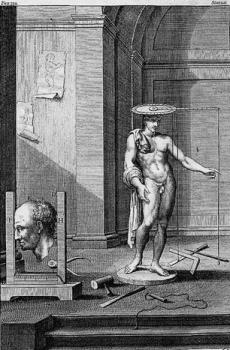Leon
Battista Alberti and the Art of Building
Salvatore
di Pasquale
Università degli Studi di Firenze,
ITALY
 "Galileo
explicitly criticized the current practice of using small scale
models to design buildings and machines, because he believed that
they could provide only mechanical information, regardless of
scale. The Galilean critique of the practice of using models is
directed at those who were convinced as to the usefulness of models,
whether architectural or sculptural, that faithfully reproduced
form without paying attention to the differences between the materials
used in the model and those used in the actual object. Alberti
strenuously defended the use of models; he was the first after
Vitruvius to list their advantages (as did Baldinucci) while,
however, specifically excluding their use as instruments for determining
the strength of a structure or any of its parts.
"Galileo
explicitly criticized the current practice of using small scale
models to design buildings and machines, because he believed that
they could provide only mechanical information, regardless of
scale. The Galilean critique of the practice of using models is
directed at those who were convinced as to the usefulness of models,
whether architectural or sculptural, that faithfully reproduced
form without paying attention to the differences between the materials
used in the model and those used in the actual object. Alberti
strenuously defended the use of models; he was the first after
Vitruvius to list their advantages (as did Baldinucci) while,
however, specifically excluding their use as instruments for determining
the strength of a structure or any of its parts.
Alberti expressed the concept
that the design is fixed in the mind that elaborates it; its form
is invariable because it is independent from the material in which
it is to be realized. In actual practice, of course, things are
not exactly as Alberti presents them, because forms are determined
by numbers and dimensions; one cannot simply ignore the importance
of the factor of the weight, except perhaps during the initial
formulation of the problem, and only then as long as the scale
of the model is not too small with respect to the object to be
realized. On the other hand, it is very probable that Alberti
was codifying a design practice used in medieval workshops where
models, due to their particular architectonic forms, were used
to resolve problems of stability, if not of strength. As we shall
see in this paper, the model of Brunelleschi's design for the
Florentine cupola appears to have served this purpose."
Order the book Nexus II: Architecture
and Mathematics
| abstract
index | previous | next
| NNJ homepage |
top of page
 "Galileo
explicitly criticized the current practice of using small scale
models to design buildings and machines, because he believed that
they could provide only mechanical information, regardless of
scale. The Galilean critique of the practice of using models is
directed at those who were convinced as to the usefulness of models,
whether architectural or sculptural, that faithfully reproduced
form without paying attention to the differences between the materials
used in the model and those used in the actual object. Alberti
strenuously defended the use of models; he was the first after
Vitruvius to list their advantages (as did Baldinucci) while,
however, specifically excluding their use as instruments for determining
the strength of a structure or any of its parts.
"Galileo
explicitly criticized the current practice of using small scale
models to design buildings and machines, because he believed that
they could provide only mechanical information, regardless of
scale. The Galilean critique of the practice of using models is
directed at those who were convinced as to the usefulness of models,
whether architectural or sculptural, that faithfully reproduced
form without paying attention to the differences between the materials
used in the model and those used in the actual object. Alberti
strenuously defended the use of models; he was the first after
Vitruvius to list their advantages (as did Baldinucci) while,
however, specifically excluding their use as instruments for determining
the strength of a structure or any of its parts.